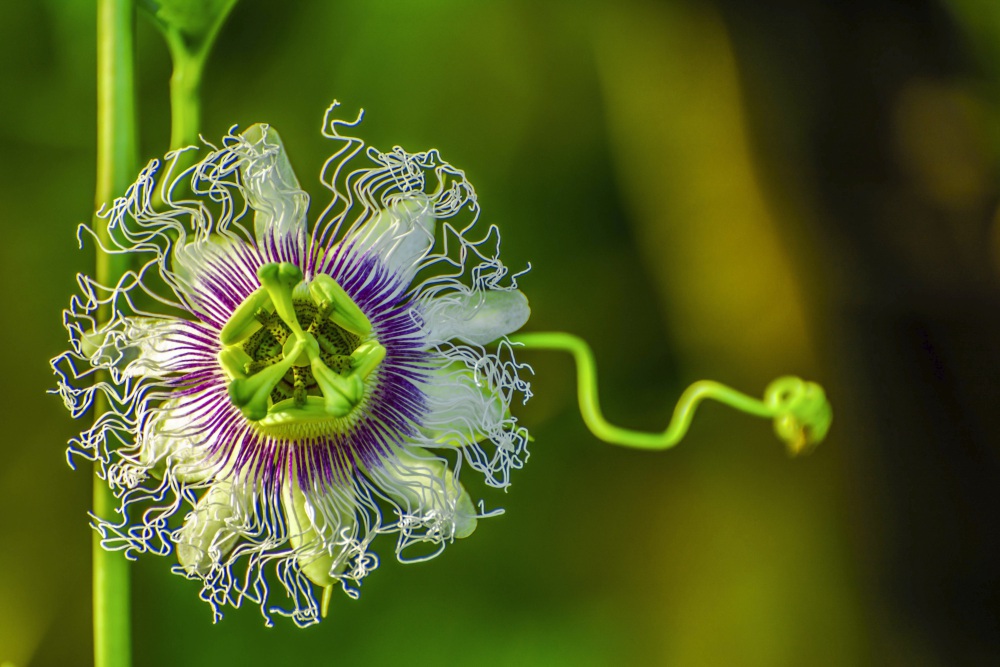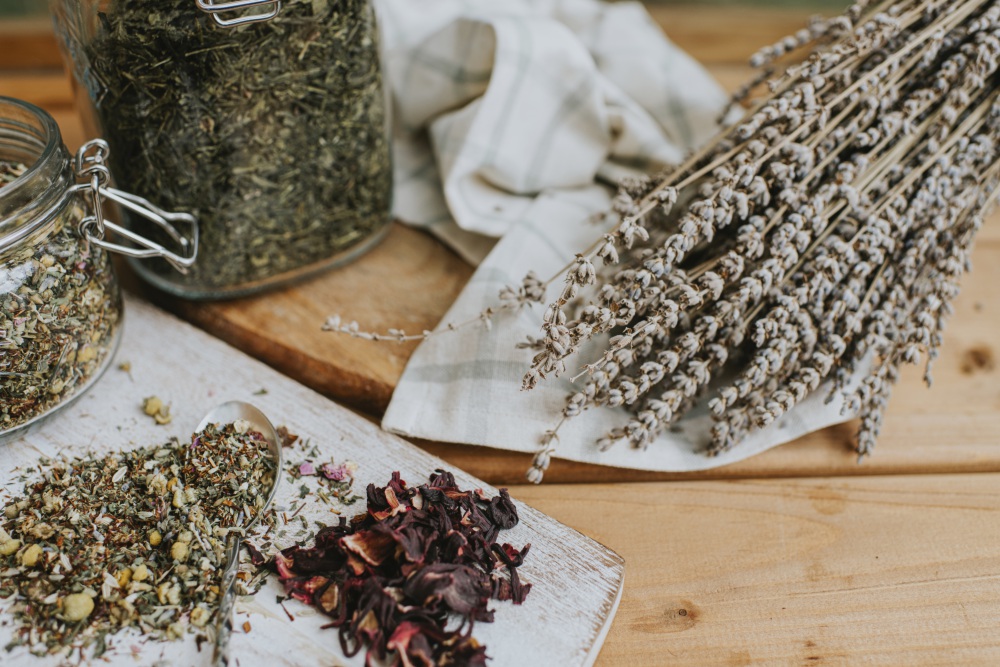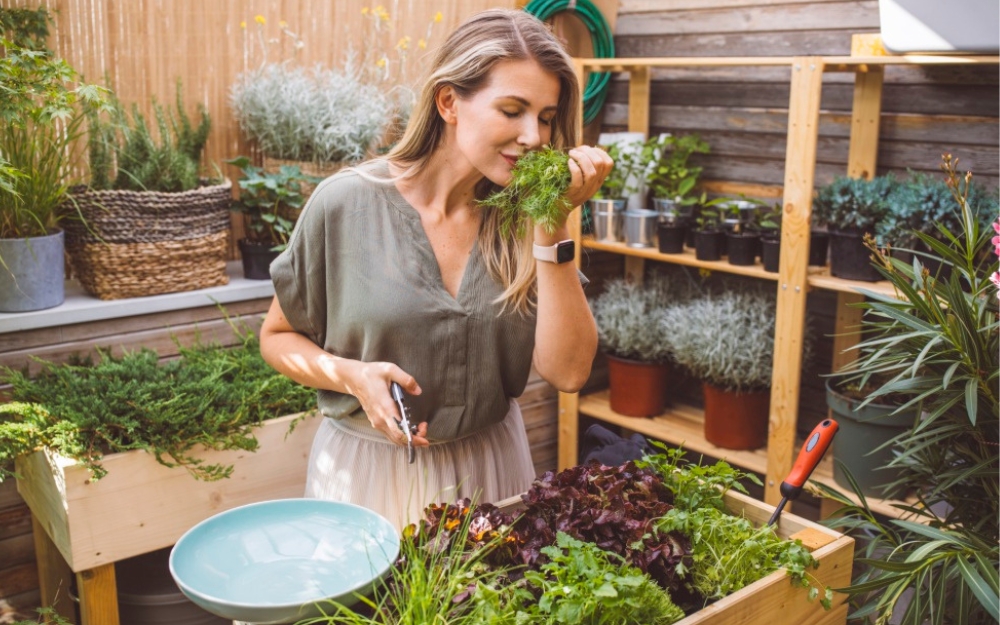Restorative homegrown herbal tea is easier to make than you think – and just a few containers of herbs on a windowsill or patio will grow enough for many cups of tea! Simply prep the soil, plant your chosen leaves, flowers, fruits and seeds, or roots, and water regularly. Before you know it, you’ll have your own homemade herbal tea garden. Once you’ve harvested and washed your herbs, experiment with different blends and mix herbs together to create unique flavour combinations.
PLANT
Leaves

Passionflower
Anise, lemon balm, lemon verbena, lemongrass, mint, tea bush (Camellia sinensis), holy basil, catmint, hyssop, nettle, passionflower, bronze fennel, rosemary, stevia, lemon thyme.
Flowers

Honeysuckle
Anise hyssop, calendula, chamomile (German), cornflower, bergamot, lavender (English), red clover, hibiscus, sweet violet, pennyroyal, linden (tree), jasmine, rose, honeysuckle, saffron, yarrow.
Fruits and seeds

Elderberry
Blackcurrant, blueberry, elderberry, goji berry, lemon, raspberry (leaves and berries), strawberry, rosehip, coriander, fenugreek, dill, fennel.
Roots

Echinacea
Chicory, echinacea, ginger, licorice, turmeric, valerian, dandelion, purple angelica.
BLENDS
Any of these tea blends can be sweetened with honey if desired.
GO-TO: Lemon, ginger and rosemary.
IMMUNE BOOSTING: Mint, calendula, fennel seed and ginger.
DIGESTIVE: Mint, chamomile, fennel seed and holy basil.
SPRING IMMUNITY & ALLERGY RELIEF: Fresh elderflower – that’s it! (Can add lemon juice and honey).
WINTER IMMUNITY: Elderberries and cinnamon stick. Or spice it up for a real winter warmer with ginger, turmeric, lemon or orange juice.
RASPBERRY LEAF: 1 teaspoon dried raspberry leaf per cup of hot water. Delicious served cold with ice and a few raspberries added.
Top tip: Preserve your herbal tea ingredients by storing them in a warm, dry place with good air circulation. Once dried, store in an airtight container. To make your herbal tea, steep 1-2 teaspoons of your chosen ingredients in hot water for five minutes and enjoy.*

NATURAL SLUG BAIT
Preserve tender seedlings from slugs in spring when the ground is moist. This recipe will make enough to fill four small bowls, which you dig into the garden bed so the lip is level with the soil (so the slugs can dive in easily but can’t get out). Slugs love the stuff!
3 cups water
3 teaspoons sugar
3 teaspoons flour
1 ½ teaspoons dried yeast
Add all the ingredients to a jar and shake well. Pour into partly submerged containers. Empty the containers into your compost every few days (or after rain) and set up a new batch. Cheap and organic.
GARDENING BY THE MOON
Maramataka is the traditional Māori lunar calendar, which can be used in all sorts of decision-making and management processes. One of its functions was to guide the gathering of kai (food), including gardening and fishing.
Gardening by the moon has been practised for many centuries. The strong gravitational pull of the moon affects the moisture levels in soil, as well as how quickly seeds germinate and plants grow.
Maramataka is derived from the word marama, meaning the moon. Thus, maramataka uses stars and lunar phases.

Edited extract from Secret Gardens of Aotearoa by Jane Mahoney and Sophie Bannan, photography by Jane Mahoney, Josephine Meachen and Sophie Bannan. (Allen & Unwin NZ, rrp $49.99).
Whiro (new moon)
As the moon grows, light and gravitational pull start to increase. Seeds sown during this period have a high chance of germinating. Strong sap flow encourages plants to grow, so this is a good time for transplanting and to start fertilising. Whiro is the night of the new moon.
First quarter
This is a productive time in the garden, ideal for sowing or transplanting fruiting and flowering crops. The light becomes stronger while the pull becomes less. This makes it a good time for leaf crops. With the sap flowing, there is a lot of growth above ground.
Rakaunui (full moon)
There is high energy three days before and three days after the full moon. This is a good time for fertilising, but seed sowing and transplanting should be avoided. High energy will cause a flush of growth followed by weak plants.
Last quarter
After the full moon, sap starts flowing downwards, supporting strong and healthy roots. This is a good time to sow root crops and for transplanting. The time of rest comes as the light and gravitational pull decreases. This is a good time to prune, harvest and weed the garden.


